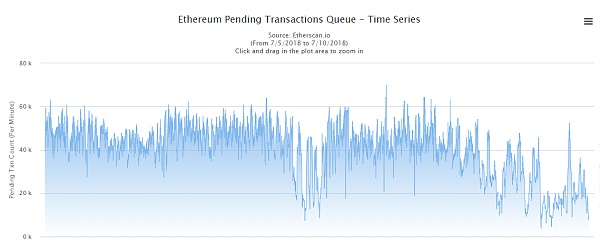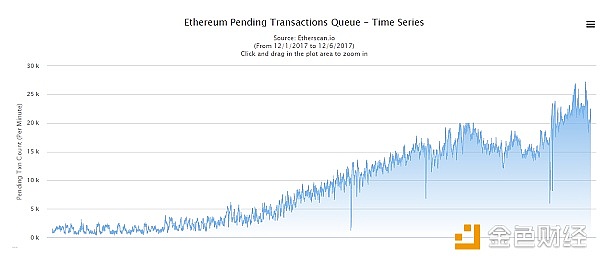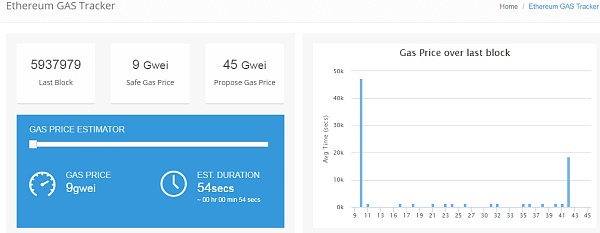Ethereum trading fee is too high? Teach you how to set up a transfer miner fee
There is a paragraph that does not count as a paragraph: If you want to know if it is a bull market now, let’s see if the Ethereum network is congested.
However, what is embarrassing is that the bear market is still far away, and the Ethereum network is blocked. Not only is the transaction transfer slow, but the miners’ fees are also doubled. Even a small buddy said that a small partner is eager to quickly reload the 1.5 ETH miners.
Regarding the congestion of the Ethereum project, this time is not because of encrypting cats, nor because the bull market is busy trading and making money. The root cause lies in the fierce exchange competition. The innovative mining and currency rules have caused a large number of ERC20 Token small amounts. The order appeared, causing continuous congestion in the Ethereum network.
The direct consequence of congestion is that ETH and Ethereum cryptocurrency will be slower, and will result in a direct increase in transaction costs (miners). Although it is difficult to see a high miner fee of 1.5 ETH in practice, it is also from the side. Explain the seriousness of the problem.
Then, the cryptocurrency transaction in your hand will not be affected by the congestion of the Ethereum network. How to set the miner fee reasonably? I believe that some of my friends who have just entered are not very familiar with them, so the following Golden Finance will come to a lecture on science knowledge.
1. Ethereum network congestion, what currency transaction transfer is affected
First, the ETH transfer transaction will definitely be affected. In addition, all Tokens based on the collapse of the ERC20 standard will be affected the same.
2. How to judge whether a cryptocurrency is ERC20 Token?

It can be viewed in the Ethereum browser (https://etherscan.io/tokens), which lists all Tokens based on the ERC20 standard. As you can see from the screenshot above, there are 98,365 cryptocurrencies at the time of writing, and the numbers are huge. If you want to search for that kind of currency, just enter the Token name you need to find in the search bar on the upper right side.
It must be pointed out that the Token attribute of some public chain projects will change. For example, EOS is ERC 20 Token in the early stage of the release. However, after the main online line on June 2, it became the main network currency, no longer the ERC20 Token. Other public chain projects, such as AE, ELF, etc., will have similar changes if the late public chain goes online.
3. Will trading transactions in the exchange be affected?
will not. Trading in the exchange is only the transfer of the book number, and the actual transfer is not carried out in the chain. Only from the exchange to withdraw money, or the wallet to recharge the exchange, wallet and wallet will be affected by network congestion.
4. How to check if the Ethereum network is congested
If the Ethereum network is congested, you can view the number of unprocessed transactions through the Ethereum browser. For details, please visit: https://etherscan.io/chart/pendingtx

As shown above, the chart counts the number of pending transactions in the network in recent days. It can be seen that in recent days, the number of transactions to be processed on the whole network has been more than 40,000 for most of the time. It has eased yesterday, but there will still be high peaks.

With a transaction number of more than 40,000, what is a concept, you can simply make a comparison: in early December, the pet game CryptoKitties prevailed, causing network congestion and a sharp increase in transaction costs. The author saved the screenshot of the transaction volume at that time, and can see the so-called congestion and network at that time. The transaction volume to be processed has just exceeded 20,000, and the peak value is no more than 30,000.
In contrast, the network congestion in Ethereum has been greatly eased in recent days, but the transaction volume to be processed is still more than 40,000, and the peak value is more than 60,000, far exceeding the congestion of CryptoKitties.
Therefore, there is no uniform standard as to what extent it is congested. Because our ability to withstand will gradually increase, for example, last year we felt that the transaction volume of more than 20,000 transactions was blocked, but it is common practice to watch 20,000 tickets now. In addition, the performance of the Ethereum network will continue to escalate, and more transactions in the future may not be said to be blocked.
But for now, the number of pending transactions exceeds 20,000, and the network is relatively congested. More than 40,000 pens are undoubtedly very congested, and more than 80,000 pens can be used in extreme times.
However, even if this number is reached, the transfer speed of the Ethereum network is actually not too slow to exaggerate. Now the Ethereine network’s transaction processing speed is about 20 per second, and it can process about 1.72 million transactions a day. Unless the miner’s fee is set very low, there will generally be no long-term failures.
5. How much is the miner’s fee set?
According to the current processing speed of Ethereum, it is not too much time to process all the tens of thousands of transactions. However, the rule for miners to deal with transactions is that whoever gives a high transaction fee will prioritize packaging and deal with who trades. So if the miner’s fee for the new trade order is set higher than you, then your trade will be put on hold and will not be processed for a long time.

Therefore, the high level of miners’ fees is appropriate, mainly referring to the overall level of the overall network miners’ fees. The numerical reference can still be viewed through the Ethereum browser (https://etherscan.io/gasTracker), which will refer to the nouns of Gas and Gas Price. Here, you only need to know the final miner fee. It is just the result of Gas Price×Gas.
When the network is not congested, the Gas Price displayed above is usually a single digit. At this time, it is usually not necessary to set a transaction fee that is too high to complete the transfer.
When the transaction fee is high, the Gas Price value is likely to rise to more than 100. At this time, if you want to transfer money quickly, you will have to pay a high transaction fee.

In terms of specific operations, the currency is exchanged from the exchange. Some exchanges adopt a method of charging a fixed value fee. For example, the ETH is a fee of 0.005 ETH, which is a relatively high number. However, the reprinting speed is usually very fast, and it is usually within a few minutes. Other ERC20 Tokens are generally deducted from the corresponding amount of currency as a handling fee.

For wallet applications, whether it is trading ETH or other ERC20 Token, the miner fee is ETH. Wallets generally recommend a more suitable miner fee based on network congestion. This value is an average value, the transfer speed is faster, usually a few minutes to a few hours, if there is no special demand default value can meet the demand.
If there is a need to invest in the transaction immediately, to ensure that the rate of payment is not lost, you can increase the fee. The specific settings of different wallets are similar, mainly by manually filling Gas Price and Gas to determine the amount of miners. The estimation of the value can be determined by using the value displayed by Gas Price in the Ethereum browser mentioned above and the estimated time.
In general, the current performance of the Ethereum network is not able to withstand the pressure on the network caused by unexpected events. At any time, there may be network congestion and increased miners’ fees. As a user, what we can do is check the network status before transferring funds, and reasonably adjust the miners’ fees to avoid the loss of time and opportunity caused by network congestion.
We will continue to update Blocking; if you have any questions or suggestions, please contact us!
Was this article helpful?
93 out of 132 found this helpful
